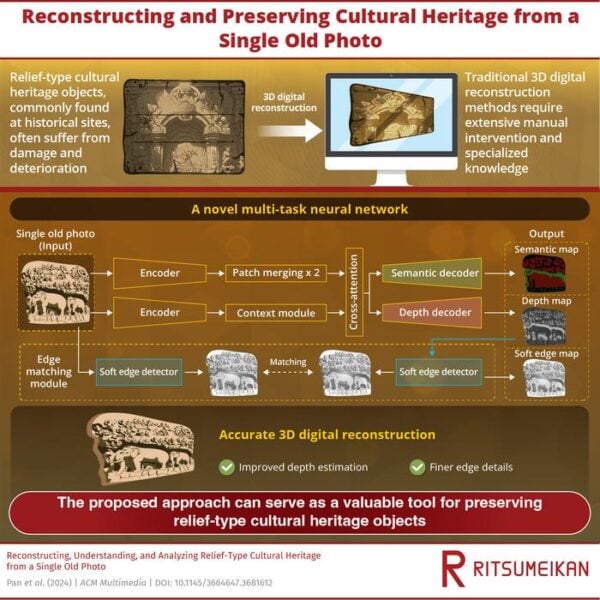Summary: Japanese and Chinese researchers have developed a groundbreaking AI system that can create detailed 3D reconstructions of ancient relief carvings from single photographs. The technology has successfully revealed hidden reliefs at Indonesia’s Borobudur Temple, achieving 95% accuracy in reconstruction while preserving fine details previously lost to traditional methods. This innovation opens new possibilities for preserving and experiencing cultural heritage through virtual reality.
Journal: MM ’24: Proceedings of the 32nd ACM International Conference on Multimedia, October 28, 2024, DOI: 10.1145/3664647.3681612
Reading time: 5 minutes
The Hidden Treasures of Borobudur
Beneath the reinforced walls of Indonesia’s ancient Borobudur Temple lies a wealth of artistic heritage, hidden from view for generations. These concealed relief carvings, which once told stories through figures protruding from stone walls, have remained inaccessible since their coverage during Dutch colonial times. Until now.
A breakthrough by researchers from Ritsumeikan University and the University of Science and Technology Beijing has made it possible to digitally resurrect these hidden masterpieces using nothing more than old photographs.
Turning Photos into 3D Reality
The research team, led by Professor Satoshi Tanaka, has developed an innovative AI system that can transform flat historical photographs into detailed three-dimensional digital reconstructions. “Previously, we proposed a 3D reconstruction method for old reliefs based on monocular depth estimation from photos. Although we achieved 95% reconstruction accuracy, finer details such as human faces and decorations were still missing,” explains Professor Tanaka.
The challenge wasn’t just about preservation – it was about bringing back lost details that even modern 3D scanning can’t capture. While current technology can document the present state of damaged artworks, it can’t show how they looked before deterioration began.
The AI That Sees Like an Artist
The team’s solution is a sophisticated neural network that approaches images more like an artist studying depth and shadow than a traditional computer. The system performs three simultaneous tasks: analyzing the image’s content, estimating depth, and detecting subtle edge variations that create the illusion of depth in relief carvings.
What makes this technology special is its ability to understand “soft edges” – the gentle transitions in depth that give relief sculptures their artistic power. Unlike conventional systems that see edges as simple boundaries, this AI recognizes subtle variations in curvature, much like how human eyes perceive depth in ancient carvings.
Preserving Heritage for Future Generations
The impact of this technology extends far beyond Borobudur. As Professor Tanaka notes, “Our technology holds vast potential for preserving and sharing cultural heritage. It opens new opportunities not only for archeologists but also for immersive virtual experiences through VR and metaverse technologies, preserving global heritage for future generations.”
Glossary
- Relief carving: Sculptural artwork where figures protrude from a flat background
- Monocular depth estimation: The process of calculating depth information from a single 2D image
- Neural network: A computer system designed to recognize patterns, inspired by the human brain
- Soft edges: Gradual transitions in depth or curvature that create subtle visual effects in reliefs
Quiz
- Q: What unique feature of relief carvings makes them suitable for reconstruction from a single photo?
A: They have shallow depth and are meant to be viewed from the front or sides - Q: What accuracy rate did the new AI system achieve in reconstruction?
A: 95% - Q: What type of edges does the new AI system specifically detect to improve reconstruction?
A: Soft edges (variations in curvature) - Q: Where was this technology successfully tested?
A: At the Borobudur Temple in Indonesia
Enjoy this story? Get our newsletter! https://scienceblog.substack.com/


